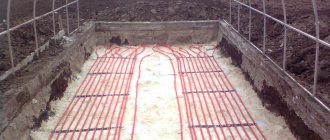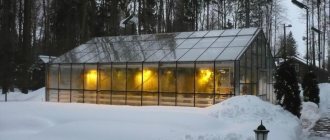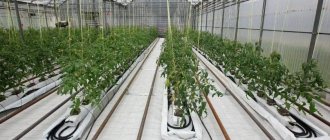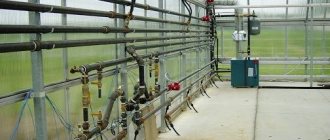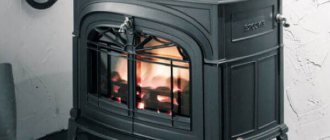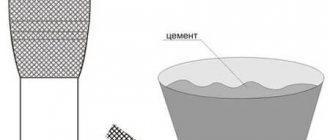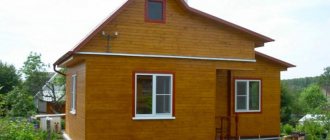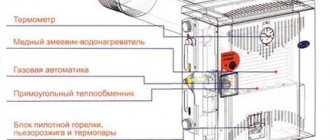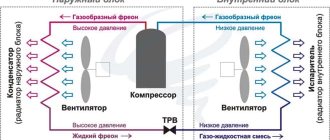This article presents photos and videos of the company GRV (Gruzdev boilers)
Greenhouses are actively used for growing cucumbers, tomatoes, lettuce and other crops year-round. In the greenhouse, with the help of heating equipment, boilers and heat generators, air and soil are heated to the required levels. Temperature directly affects the development of vegetable crops as well as watering, sunlight and nutrients. In addition, the risk of pests is reduced, which affects the quality of the crop in the end, and the presence of diseases with proper disinfection of the soil after building a greenhouse, the risk of diseases is greatly reduced.
There are special requirements for temperature conditions in nurseries; for them we recommend combined boilers that heat air and water. Hot water is used to heat the soil and the irrigation system, and hot air is used to heat and ventilate the greenhouse.
Rice. 1 Photos of GRV heat generators for shipment for heating greenhouses
The GRV solid fuel heat generator was originally designed for heating greenhouses, but has found a very wide range of applications. Over the past two heating seasons, we have improved aerodynamics and increased the efficiency of the unit. Due to its high properties, the heat generator is also used for drying, and some greenhouse farms use it all year round. In summer for drying chambers, in winter for heating.
Heating can be: with manual fuel loading and automatic
Rice. 2 For heating in manual mode, a slab is suitable. GRV heat generators are adapted for this
For heating: air heating, combined heating (we heat air and soil), water heating registers.
In order to heat a greenhouse with an area of 500 sq.m. you will need:
1. Concrete platform for placing the heat generator under its base
2. A set of air ducts according to diagram No. 1 or diagram No. 2 (see below)
3. Perforated mounting tape for mounting air ducts or fastening according to the drawing (see below)
4. If there is no 380V voltage on the site, then you should purchase a frequency converter (you can order from our company) it will convert from 220V to 380V.
5. Next, the installation of air ducts and chimney installation is carried out
This system is guaranteed to work only with GRV heat generators, which already operate more than 40 greenhouses throughout Russia. TG and “pyrolysis” heat generators are not intended for heating greenhouses.
Particular attention is paid to the design of the heat generator, which should ensure operation with the same efficiency as a hot water boiler
Rice. 3 Decoupling unit. The so-called “pants” are needed to distribute air on the left and right sides
Rice. 4 Different colors indicate different elements of the duct system
Please note in diagram No. 1 that the fuel loading neck and the firebox door are located outside the greenhouse. Firstly, this allows you not to enter the greenhouse at night, i.e. Close it with a lock, do not let it get too hot. The firebox and ignition are carried out outside the greenhouse. You can make a light shed or make a boiler room from lightweight structures. It is important to occupy the minimum usable area of the greenhouse. Every square meter of a greenhouse should be profitable.
Rice. 5 Installation of air ducts in a wooden greenhouse
To secure the air ducts, you should use perforated mounting tape, which can withstand high tensile loads and is easily mounted to the greenhouse frame
Rice. 6 Mounting tape for air ducts
When choosing a layout of air ducts, you should contact a specialist at GRV; depending on the design of the greenhouse and the type of plants, the air ducts should be placed differently and the selection of fans should also be chosen correctly
Rice. 7 Installation diagram of the GRV heat generator, which runs on coal and wood. Fuel can be loaded from the street, this reduces the number of unnecessary visits to the greenhouse
Rice. 8 Photo taken during operation of a 400 kW heat generator. Most of the smoke is steam, since usually freshly cut firewood and slabs with high humidity
The heat generator can be supplemented with automatic fuel supply, a vortex burner using pellets, husks or sawdust.
Rice. 9 Heat generators are long, which allows the use of any slab or wood waste for heating the greenhouse
Rice. 10 For stability, the heat generator is turned over on its side
Rice. 11 Vortex burners on pellets for heat generators and boilers. Installed inside the greenhouse
Using the example of objects with greenhouses, an automatic fuel supply system reduces labor costs by 2-4 times. One person is able to control the heating of 5 operating units at once, this is more than 10,000 sq.m. greenhouses
Rice. 12 For particularly large heat generators, the chimney is installed inside the mast
A very detailed video on the installation and design of the heat generator is presented below. This object is located in the Krasnodar region. A wood-fired heat generator with a power of 400 kW heats a greenhouse area of 2000 sq.m. All types of crops are grown in the greenhouse. Type of fuel: firewood, slab. An extension has been organized for the heat generator, which is combined with the greenhouse. But a roof made of non-combustible material is installed above the heat generator. We have selected the most minimal radial fans to reduce energy costs. In a greenhouse, which is very important, the humidity process is optimized; plants are less susceptible to diseases than with high humidity. Since the GRV heat generator gives a large temperature delta, it is easy to ventilate the greenhouse in any weather outside, additional air intake from the street is possible, and not cold but heated air enters the greenhouse
Fully automatic greenhouse heating with air heat generator GRV
Air heating using GRV heat generators allows you to effectively maintain the microclimate in the greenhouse in accordance with all requirements for temperature and humidity in the greenhouse. GRV heat generators for greenhouses are designed with a power reserve and maximum efficiency for these devices. Automatic piston fuel supply has greater force than auger fuel supply, does not fail when foreign objects enter, and is easy to maintain.
To control the temperature, the heat generator comes complete with a control panel based on the domestic programmable controller PR200 with wide functionality and the possibility of additional expansions at the request of the customer.
Rice. 13 Scheme of a greenhouse and air heating with fully automatic operation
Video of the operation of an automatic heat generator for air heating
Rice. 14 Top view plus specification of elements for heating a greenhouse of 500 sq.m.
Rice. 15 This is the diagram for installing a heat generator for heating a greenhouse. Its location should be close to the exit from the greenhouse. Due to the large bunker, loading is carried out once a day or once every two days, depending on the outside temperature
As mentioned above, air heating is fast, efficient and inexpensive. But there are objects in which installing air heating is problematic, for example, many free-standing greenhouses, or a greenhouse with an area of 10 thousand square meters. In this case, we install water heating boilers with automatic or manual fuel supply.
Rice. 16 Universal hot water boiler for heating an industrial greenhouse. The boiler is installed directly
Heating of a greenhouse with an area of 1000 sq.m. usually carried out by a boiler of 200 kW per hour.
- Heating can be either air or water using a network of registers and an assembly manifold.
- If there are several greenhouses, preference should be given to the automatic GRV series (they come with a universal firebox)
- The hot water boiler is installed in a greenhouse or boiler room. To install the boiler in a greenhouse, you should use a special “vestibule”; if you heat it manually with wood or coal, opening the doors is inevitable
- Mandatory reserve for the power of the boiler and the heating system itself
- The boiler must be more powerful than the heating system for firing at night in the winter when there is no heat source in the form of the sun
Rice. 16 Heating a greenhouse 1000 sq.m. hot water boiler
It is important that when choosing a boiler, the size of the firebox is taken into account. In winter, there is a lot of worries in the greenhouse, and it is not always possible to burn with chopped wood.
Rice. 17 Piping unit for two heating of two greenhouses with an area of 2000 sq.m. at an existing facility
Rice. 18 Scheme of hot water heating of a greenhouse using air heaters. This greenhouse has an area of 600 sq.m. To cut off the cold, registers are laid on the sides of the greenhouse in two branches of 76 mm pipe. The heaters are powered from registers, thus saving material and reducing the cost of the main pump. The uniformity of the flow is ensured by installing a small capacity pump on each heater
Rice. 19 On the previous slide, a scheme for hot water heating of a greenhouse can be developed; a universal boiler GRV 150 is installed in the boiler room of the greenhouse, which runs on pellets and wood. A firebox with a length of more than 1500 mm provides the ability to dispose of solid waste
Design and operating principle
A pellet boiler consists of a fuel hopper, automation and burner. The pellets are delivered via an external auger to the pre-firebox, and from there they are fed via an internal auger to the burner nozzle. After the pellets hit the nozzle, automatic ignition and the supplied pellets are completely burned.
In terms of calorific value, burning 1 kg of pellets is comparable to half a liter of diesel fuel and amounts to 5 kW/hour. Compared to firewood, due to the high density of the pellets, their combustion is much more efficient and productive , eliminating the possibility of spontaneous combustion. In addition, ash cleaning can be done much less frequently, reducing this process to once a week. When using pellets as fuel, carbon dioxide emissions into the atmosphere are reduced, which leads to a reduction in the greenhouse effect.
Installing a pellet boiler requires compliance with certain rules, thanks to which it will be possible to avoid possible alterations during its operation:
- it is more expedient to install the boiler in a separate room, for example, a basement or an extension;
- the flooring in the boiler room should be made of ceramic tiles or concrete;
- the room that will be used as a boiler room must have enough free space to allow repairs and maintenance of the boiler;
- the room should be dry, well ventilated, with a constant temperature within +100C.
An important indicator for any type of boiler equipment is its efficiency . In order to more clearly understand the efficiency of a pellet boiler, let’s compare it with other equipment used for heating a house. Thus, the efficiency of wood is in the range of 35%, of natural gas - 87.1%, of electrical energy is 97%, and of burned pellets is in the range from 86% to 93%, depending on the model of the pellet boiler.
This material will help you make a solid fuel boiler:
Types of greenhouse heating
Natural resources and other heat sources will help to heat the greenhouse. To build a winter greenhouse, you must also take care of proper insulation of the frame in order to reduce fuel costs. The top of the polycarbonate can be covered with thermal insulation. Depending on the budget, there are several methods for heating greenhouses:
- Sunlight.
- Air heating.
- Gas equipment.
- Furnace equipment.
- Electrical elements.
- Biological fuel.
- Water heating of the room.
It is worth considering several factors, including: the location of the greenhouse on the surface of the earth, the climate zone. The heating method depends on the temperature range required indoors. If necessary, the greenhouse is insulated, protecting it from severe frost and gusts of wind.
sunlight
Ultraviolet light is involved in the process of photosynthesis in plants. It is necessary to obtain a full harvest. The advantage of sunlight is availability and environmental safety. To evenly heat the air inside the room, the greenhouse is installed on the south side of the site, so the plants will not experience a lack of sunlight. The only drawback is winter, since the intensity of energy received from the sun decreases.
Air heating
The method of pumping warm air into a room is very common. It is used to raise the temperature in a greenhouse for a short period of time, as fans can dry out the air. For uniform heating of the greenhouse, thermal curtains and guns are used. When using air heating, care must be taken to maintain optimal humidity in the greenhouse. To do this, place containers of water around the perimeter.
On a note!
Plants should not be allowed to dry out. It is necessary to carefully monitor air humidity.
Gas equipment
In areas where there is gas heating to heat the greenhouse and grow crops, it is advisable to use nitrogen. It will simplify the task of installing the system. In other places where gas equipment is not available, propane cylinders can be used. To heat a small area, several containers of gas are used.
Propane is explosive, so precautions should be taken when working with it
Furnace equipment
Firewood is an affordable way to heat a greenhouse after gas. A brick or metal stove or solid fuel boiler can heat both a small and a large area. Wood is safe for humans and has high efficiency when burning in a firebox. The boiler is installed in the center of the greenhouse, with a chimney pipe leading up. Pellets and wood briquettes are used as fuel for stoves. Furnace equipment can accumulate energy indoors for a long time.
Electrical elements
Electric radiators and heating systems are the least used to maintain heat in a greenhouse. Due to rising prices for metered tariffs, this is an expensive way to warm up the greenhouse area. Infrared heaters are in high demand, although they are not economical in energy consumption. There is a more effective way - heating the greenhouse with a heating cable. The wire is laid in a “snake” pattern at the bottom of the prepared trench and covered with sand on top. Thanks to the innovative method, the soil and air are heated evenly, and the temperature can be adjusted using a rotary indicator.
Biological fuel
A valuable and useful product for warming the soil in early spring is biofuel. It contains straw, tree bark or manure. Compost is prepared in advance or purchased ready-made in bags. The waste products of cows or birds can warm the soil to the optimal temperature so that plants develop in comfortable conditions. The greenhouse will be able to retain heat for several months. Biofuel is a low-cost resource for energy storage.
Water heating of the room
Water heating systems are universal and generally include a tank of hot water. The heat source of the water system can be a stove or boiler. Metal pipes of different lengths are laid around the perimeter of the greenhouse, forming a closed heating system. Before running the pipe along the ground, it is necessary to take into account the presence of paths inside the greenhouse. To save money, the paths in the greenhouse can be left unheated.
Automatic control mode
Pellet granules are stored in a separate bunker , which is connected to the combustion chamber.
Automation allows you to set a weekly program for feeding pellets into the boiler. In addition, the automation will turn the burner on or off according to the established program, which allows you to save fuel consumption and maintain the set temperature depending on the time of day. Control can be done either using the remote control or using the buttons on the display. A bunker with a volume of 200 to 300 liters ensures continuous operation of the boiler for three days. For uninterrupted operation of an average-power boiler within 25 kW, the daily norm is 5 kg. You can install an external bunker, which will greatly increase the volume of pellet loading, thereby increasing the operating time of the boiler without your intervention. The control system is responsible for the operation of the burner ; granules are fed into the combustion chamber in small batches, which eliminates the possibility of overheating. If you need to turn off the boiler, then after pressing the function button, its operation will automatically stop after 5-10 minutes, which is required for complete combustion of the loaded batch of pellets.
Environmental Safety
Thanks to the special design of pellet boilers , the ecology of your premises is not threatened. In them, the circuit through which air is supplied for complete combustion of the fuel is located separately from the circuit through which the room is heated. Due to this design, oxygen does not “ burn out ” and therefore you will always feel comfortable. Some users additionally take air from the boiler room, thereby drying and ventilating it. In addition, the advantages of a pellet boiler include the following factors:
- an energy-saving and low-noise fan capable of ensuring uniform, efficient circulation of warm air;
- low level of electricity consumption , within 60 Watts, for operation of automation and fans;
- small volume of ash and soot compared to solid fuel wood boilers;
- the boiler body does not heat up , so it is absolutely safe for animals and small children;
- automatic loading of fuel from the bunker;
- intelligent control system , timer and thermostat monitor and ensure continuous operation of the boiler depending on the set program.
You can read about the advantages of double-circuit solid fuel boilers here:
Manual loading boilers
Pyrolysis operate for the longest possible time and with the highest efficiency (up to 92%) , in which the combustion process is controlled almost 100% due to the presence of a fan.
Pyrolysis boilers should not be confused with conventional long-burning boilers, that is, boilers in which long-term operation on one load is ensured not by high fuel combustion efficiency, but by the presence of a huge loading chamber. The duration and efficiency of combustion are inversely proportional: at rated load the TTK will produce the highest possible efficiency for its design, but at the same time the duration of combustion will be minimal. When the load decreases (smoldering mode and lower temperature in the boiler), some of the fuel will fly into the sky as black smoke, but the boiler will work for as long as possible. Thus, trucks are equipped with larger fuel tanks – increasing the load on the vehicle and reducing the loading tonnage.
Among TTKs, pyrolysis ones are the most expensive. Therefore, some buyers are looking for a “more budget-friendly, but definitely pyrolysis” option. Often, such budget options do not meet the buyer’s expectations, as a result of which angry publications from dissatisfied users appear on the Internet, debunking “myths about pyrolysis boilers.” And little do they know that the budget boiler they bought as a pyrolysis boiler is, in fact, not one at all.
Therefore, here it is: either shell out money, or NOT pyrolysis. There is no third.
The main distinguishing features of real pyrolysis (gas generator) boilers from all others >>>
If it is not possible to purchase pyrolysis TTK, then it is best to opt for the classic TTK of a well-known brand that has been on the market for a long time. At the very least, you can read real reviews from owners and draw some conclusions for yourself.
Burning time . If you approach the issue of choosing a classic TTK based on the maximum indicators for the fuel burning time on one tab, then you also need to take into account the heat exchanger material and design. The fuel burning time in the TTK depends not only on the type of fuel, but also on the design features of the boiler.
Water heating TTKs borrowed the firebox design from a conventional stone stove. The only difference is that the firebox of a hot water boiler is double-walled, made of cast iron or steel, and the cavities are filled with coolant. But the inside of the firebox is the same as that of the stove - it is a box divided into two parts by a grate. The lower, smaller part is an ash pan with a door for cleaning, through which, in addition, combustion air enters, passing from bottom to top through the grate. The upper, larger part is the loading chamber, also known as the firebox, connected to the chimney. This design is typical for cast iron sectional TTKs and for many steel ones.
With this arrangement, the entire volume of loaded fuel takes part in combustion. Figuratively speaking, it’s like a melting ice cube taken out of the freezer. Therefore, the burning time on one tab depends largely on the type of fuel and its quantity. Air supply settings also matter, but do not radically change the situation.
The burning time of fuel in boilers of this design at rated load will be the same as in a stove: firewood - 2-4 hours, coal - 3-5 hours, briquettes - 2-5 hours (depending on the type).
There is a separate group of classic TTKs, which are slightly different in design from their “great-grandfathers”. We are talking about steel TTK with top loading and a shaft-type . The air supply for such boilers is also carried out from below, through the ash pan door, but fuel combustion occurs only in the lower part, and not in the entire volume. This is comparable to burning a candle or match. As the lower layers burn out, the fuel sinks down.
This design makes it possible to burn fuel in doses, allowing you to more accurately adjust the boiler operating mode. And the fuel burning time per load depends not only on the type of fuel, but also on the size of the loading shaft. For example, with coal, such boilers operate for 8-12 hours on one load. In addition, shaft-type TTKs have a multi-pass vertical heat exchanger, which makes it possible to better remove heat from the exhaust flue gases. And the built-in economizer, a device for supplying and heating secondary air, contributes to the afterburning of flammable impurities of flue gases.
If we collect data on the duration of operation and efficiency of different TTKs, we will get the following table.
Duration of operation of a solid fuel boiler on one full load at a load of 75-100% of the nominal load, hour* | |||||||
| Type TTK | Firewood | Wood briquettes (Eurofirewood) | Peat briquettes | Coal briquettes | Brown coal | Coal | Anthracite |
| Pyrolysis wood burning | 6-8 | 6-9 | 6-9 | No | No | No | No |
| Pyrolysis combi (firewood, coal) | 6-8 | 6-9 | 6-9 | 6-10 | 8-10 | 8-12 | No |
| Pyrolysis coal | just kindling | just kindling | just kindling | 6-8 | 6-8 | 10-12 | 10-14 |
| Classic cast iron sectional | 2-4 | 2-5 | 2-5 | 3-5 | 3-5 | 4-7 | 4-7 |
| Classic steel sectional | 2-4 | 2-5 | 2-5 | 3-5 | 3-5 | 4-7 | 4-7 |
| Steel top loading | 2-4 | 2-5 | 2-5 | 4-8 | 4-8 | 8-12 | 8-12 (undesirable) |
| * for boilers of the same type from different manufacturers, the data may differ. | |||||||
How to increase the operating time of any TTK on one load >>>
Disadvantages of pellet boilers
Speaking about the advantages of this type of solid fuel boilers, it is worth mentioning their disadvantages.
- despite the fact that pellets are made from wood waste, a unit of heat generated will cost more when compared with boiler equipment that runs on wood;
- It is necessary to store pellets in a dry room , since under the influence of humidity they begin to swell and fall apart, causing the augers to become clogged
- to operate autonomously in remote suburban areas, you will need to purchase a generator and additional equipment, which can make purchasing a pellet boiler an expensive pleasure;
- The consumption of granules per month can be about 1 ton . Knowing the price of pellets in your region, it is not difficult to calculate how much it will cost you to heat a country house in the winter. As practice shows, your costs will be comparable to using electric boilers and will exceed costs if you use natural gas as fuel.
